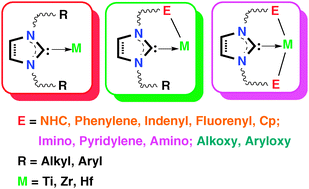N-heterocyclic carbene (NHC) complexes of group 4 transition metals
Abstract
Since the discovery of a stable N-heterocyclic carbene (NHC), the use of NHCs in chemistry has developed rapidly over the past two decades. These interesting compounds are predominantly employed in organometallic chemistry as ligands for various metal centers, and as organocatalysts for a variety of transformations. In particular, the NHC transition metal complexes have received widespread attention, and significant progress has been made in the development of group 4 NHC-complexes in the last few years. These group 4 NHC-complexes are of interest because of their unique structural properties, and their potential application in organic transformations and catalysis. This review covers the superior design strategies for NHC ligands to stabilize early transition metals and well-defined group 4 metal complexes with mono- and multi-dentate NHC ligands. In this context, four types of NHC-complexes, i.e., carbon-functionalized NHCs, nitrogen-functionalized NHCs, oxygen-functionalized NHCs and nitrogen/oxygen-functionalized unsymmetric NHCs, are described. In addition, the use of group 4 NHC-complexes as catalysts in olefin (co)polymerization, ring-opening polymerization of rac-lactide, copolymerization of epoxides and CO2, as well as hydroamination/cyclization of aminoalkenes, is presented. Furthermore, limitations and challenges are discussed.


 Please wait while we load your content...
Please wait while we load your content...